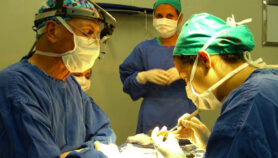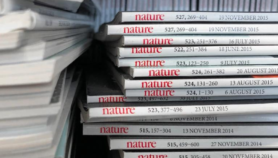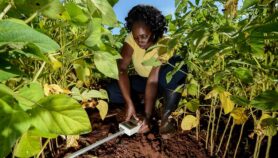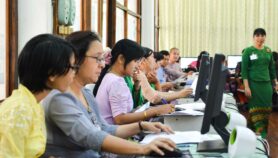By: David Dickson
Send to a friend
The details you provide on this page will not be used to send unsolicited email, and will not be sold to a 3rd party. See privacy policy.
The sharp reduction in the costs of scholarly communication brought about by the Internet has provoked a fierce debate on the costs of access to scientific information. Developing-country scientists are benefiting from the competition this has generated.
Few inventions in history have had as significant — or immediate — impact on society as the development of the Internet. It is difficult to believe that it is only ten years since the World Wide Web, based on techniques developed to allow particle physicists across the globe to exchange information easily among themselves, was created at the European Organisation for Nuclear Research (CERN) in Geneva. In that period, the ability to access information instantaneously from anywhere around the world — and at almost negligible cost — has revolutionised practically every field of economic and social activity.
One of these, not surprisingly, has been publishing, an activity dedicated to the dissemination of information. The impact of information and communications technologies (ICTs) in this field comes from their ability to virtually eliminate so-called transactional costs or the 'costs of doing business' — in this case the physical production and distribution of the information. And nowhere has this impact been greater than in scientific publishing, where the costs of printing and distributing scientific information have now, in principle, been removed for those prepared to work electronically.
Developing countries stand to gain in many ways from this technological transformation. Scientific journals and their contents are the lifeblood of the scientific community; all too frequently, however, scientists working in developing countries are deprived of this lifeblood for two reasons. Firstly, such journals can be expensive, particularly in specialist fields with short print runs. Secondly, the vagaries of postal services mean that such scientists can often be weeks, if not months, behind their colleagues in the industrialised world in keeping up with the latest developments.
With the possibility that both these barriers could be removed in one stroke, the opportunities for science in the developing world are immense. But a different obstacle immediately presents itself: if the information is made freely available, who should now pay for those production costs that have not been eliminated? And how can an equitable system of pricing and payment be developed that makes information available to individuals that need it — at a price they can afford — while adequately rewarding those engaged in making this information accessible?
The 'producer pays' model
One solution is to say that the costs of publishing should be paid by the producers — not the consumers — of scientific information. In other words, that such costs be considered as part of the costs of the research, and therefore covered by research grants, rather than being an overhead cost paid out of library funding. This, for example, is the approach that has been adopted by the Public Library of Science (PLoS), the free access publication initiative, set up with the support of many scientists keen to find an alternative to highly-profitable commercial publishing, whose first journal, PLoS Biology, was launched last month.
PLoS plans to charges researchers US$1,500 for handling every paper that it publishes, saying that this will eventually be sufficient to cover all editorial costs and other expenses. Critics argue that, while this may be a relatively small amount for a US researcher with a substantial grant from the National Institutes of Health, it could be a major disincentive for scientists in the developing world, for whom the sum could represent several months' wages. PLoS says it has taken this into account, and will waive the fee for anyone (including in particular developing-country researchers) who genuinely cannot afford to pay.
A separate criticism of this publishing model is that it reduces the opportunities to use income from scientific publishing to subsidise other professional activities. Some scientific societies, for example, frequently rely on this income to provide a range of services to their members (although others admittedly se epublishing as an end in itself). Separately, for journals such as Nature and Science (both of which provide SciDev.Net with free access to a limited number of articles each week) it allows them to carry news and information about the scientific community that would not necessarily be covered in a producer-pays publishing model.
The disappearance of such a service would be a major loss, particularly at a time when scientists are being encouraged to increase their active interaction with society (and, in a more self-serving sense, when they face a growing need to understand the internal dynamics of funding agencies). So would any reduction in the opportunities for publishing interdisciplinary research fundings. Care must therefore be taken to ensure that, in their enthusiasm to pursue free access publishing, initiatives such as PLoS — welcome as they are — do not take on an excessively narrow focus that threatens consideration of the wider social and intellectual dimensions of science.
Differential pricing
One approach to this dilemma — adopted for example by the science publishing company BioMed Central — is to adopt a hybrid scheme, charging the producers of research for processing individual papers, and the users for supplementary material that “adds value”, such as reviews. An alternative is to start with the scientific journals as they are currently produced (and financed) and then move to a differential pricing strategy, namely one in which price is broadly related to ability to pay.
This, unsurprisingly, is the model favoured by most commercial publishers (and many scientific societies). These are keen to retain revenue from those 'users' of research that are still in a position to pay, but also aware that their current pricing strategies discriminate against those in the developing world who are unable to do so.
Two international initiatives have been launched to co-ordinate the willingness of many scientific publishers to move in this direction. One, launched by the World Health Organisation last year and endorsed by UN Secretary General Kofi Annan, is the Health InterNetwork Access to Research Initiative (HINARI). This allows public institutions in developing countries to gain free — or nearly free — access to more than 2,000 journals in biomedical and related social sciences (see WHO initiative gives free access to journals). More recently, the Food and Agricultural Organisation has launched a similar initiative, again with the support of many private publishers. Known as Access to Global Online Research in Agriculture (AGORA), this gives comparable access to scientific literature in food, nutrition, agriculture and related biological, environmental and social sciences (see Poor countries get low-cost access to science journals).
The promise that both schemes offer is to guarantee free access to all material in the journals they cover for scientists working in named institutions in the world’s poorest nations. A significant limitation, however, is that the list of countries covered — based on World Bank measurements of countries with a Gross National Product per capita of less than US$3,000 — does not cover many of the larger developing countries (including, for example, not only Brazil, China and India). Their exclusion is understandable; many of the publishers that support both schemes also have a considerable number of current subscribers in these countries that they are reluctant to lose. Nevertheless this still represents a major impediment for those who argue that the goal should be free access for all developing-country scientists.
Benefits from competition
As far as the global scientific community as a whole is concerned, the main competition at the moment is between the traditional 'user pays' market model used by commercial publishers, and the free access model subscribed to by PLoS and others that seeks explicitly to challenge conventional practices. Fortuitously, developing countries have been one of the main — if unintended — beneficiaries of this competition.
On the one hand, such countries are able to benefit directly from free access initiatives. On the other, there seems little doubt that it is the pressure on commercial publishers from such initiatives that is fuelling their enthusiasm for schemes such as HINARI and AGORA, where the relatively minimal costs involved are — such publishers hope — more than compensated for by the public relations dividend.
It would be naïve to believe that the future is going to belong to one model or the other. But neither would that necessarily be desirable, at least as far as the developing world is concerned. For, in the case of both models, one of the by-products of the competition between them is that resources are essentially being channelled from the scientific communities of the rich to the poor nations of the world. The latter already face a number of impediments, such as poor quality, high-cost connections, that limit their ability to benefit from the communications revolution that is sweeping the scientific community. All the more reason, therefore, to welcome any move that reduces their cost of access to publishing opportunities and journals, both of which lie at the heart of the capacity-building endeavours that developing countries so badly need.
SciDev.Net is launching a special feature on Open Access and Science Publishing later this week, which will include news and opinion articles on the issues raised, details of open access initiatives and literature, and links to key reports, meeting proceedings and future events.













